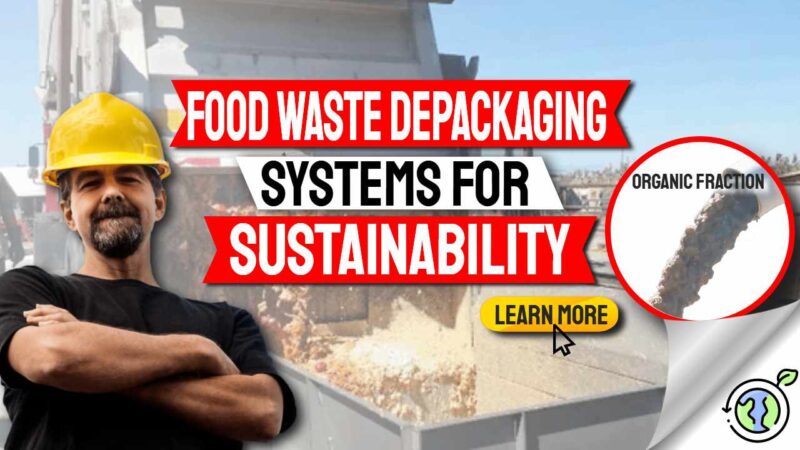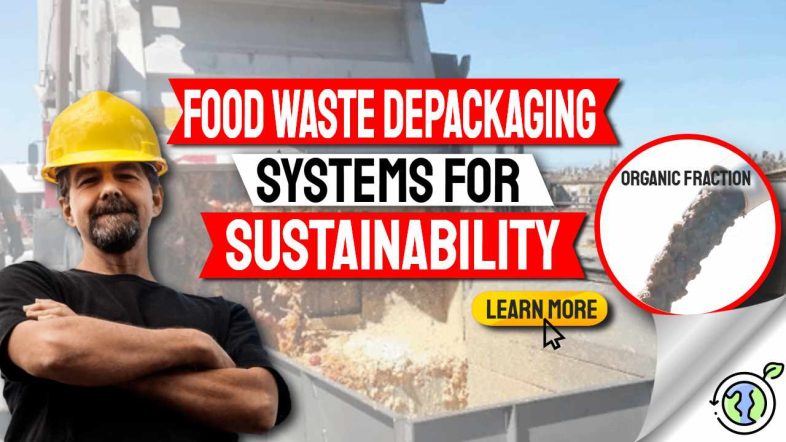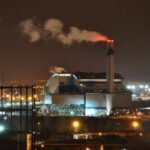Food Waste Depackaging systems are increasingly being designed for sustainability and microplastic reduction which many would say is vital for the survival of our planet.
Many people are interested in the rapidly growing anaerobic digestion sector, which uses mechanical equipment called depackagers or separators, to produce contaminant-free food waste slurries that may be piped into wet biogas digesters.
The Food Waste Depackaging Sector is particularly interesting at this time. More food recycling as a result of the implementation of COP26 based government pledges to meet net-zero targets will inevitably raise the demand for this equipment.
At the same time, innovative new packaging systems are appearing which avoid microplastics creation in the process. With these and other measures to reduce the carbon footprints of these products, we predict that this will be a growing market for many years to come.
Read on to find out more about our definition of sustainable repackaging systems:
What is a Sustainable Depackaging System?
The aim is to separate packaging from organic matter cleanly without creating microplastic while complying with the waste hierarchy for efficient operation of the circular economy and to the fullest extent possible to process plastics for recycling and organic materials for efficient materials use and energy production, and all with minimum carbon emissions.
They transport garbage from the hopper to the bag package pot and sacket opening stage, where compression bursting, shear force and vibration, is used in separation equipment in a smooth and efficient low energy use manner.
This produces separate outputs of a grit, silt and sand and outsize fraction, a clean plastic fraction and an organic fraction or “soup”. The resulting output stream may be washed, dried, further separated and baled as the waste processor requires in order for it to be sold to the most economically rewarding market available.
The goal of sustainable depackaging is to remove the packaging with as little damage as possible in order to minimise the production of microplastics and the mixing of inert substances with biological matter. It accomplishes this by:
1. Pulling and bursting open the packing rather than shredding it
2. Compressing and decompressing garbage in order to remove organic materials
3. Cleaning the packaging to eliminate all organic matter residues.
The actions of knives, blades, hammers, milling and all shredding are avoided in all truly sustainable repackaging systems in order to, as far as possible, avoid microplastic production.
The verdict on just how damaging microplastics will prove to the global environment may still be awaited while ocean research continues. However, the dangers to higher life forms of ingestion are undeniable, and the effect on the ability of ocean plankton to remain vigorous and healthy in floating microplastic debris could be devastating for ocean food production.
As a result, there are two different waste recyclate streams of real value:
- Plastic packaging debris that is acceptable for recycling and easily rendered hygienic for safe reuse
- Organic matter (biowaste) can be used as a biofuel, such as in an anaerobic digestion facility.
To eliminate packaging from food waste, sustainable depackaging devices use cutting-edge technology. The pace of development of that technology is now rapid due to pressure from governments and the public to stop damaging our environment and avoid mass species extinction.
Food Waste Depackaging Systems
Food depackaging equipment is supplied to the US market by both American and European businesses.
Doppstadt
Doppstadt manufactures depackagers. Also is a German firm recognised in the composting industry for its grinders and trommel screens, and it manufactures a screw press for food waste depackaging.
A screw press is a slow-moving device that dewaters by using constant gravity drainage.
Another manufacturer of this sort of equipment is Dupps. It is an 84-year-old Ohio-based rendering equipment firm that works in collaboration with the Netherlands-based Mavitec to produce and market rendering and depackaging equipment.
Mavitec
The original Mavitec food waste depackaging system included a shredder with interchangeable screens, a screw press for extruding the food wastes to separate them from the packaging, and a stainless-steel washing drum for the reject stream.
Dupps
The Dupps food waste depackaging technology separates organic from non-organic elements, including plastics and paper packaging. It’s great for converting food industry waste, retail and restaurant garbage, and any other food items that may be recycled into profitable, value-added goods.
The Dupps food waste depackaging system has a feedstock capacity of up to 350 cubic feet per hour, depending on material composition, and is small and easy to maintain. Brochure for a food waste depackaging system.
Drycake
The TWISTER De-packager and Separator from Drycake allow waste processors to separate packaging from food or other organic material. The company has been operating for 20 years. In this period the disposal of organics has become a global problem and the company has grown to provide a range of products to serve this growing market sector.
The company is an expert at diverting post-consumer and food industry waste/ expired food waste from the retail industry which can’t be distributed to food banks, away from landfills.

How a Depackaging System Works
Food waste is a costly commodity, and the responsibility to recycle more falls squarely on the businesses that generate or manage it. Packaged food waste is frequently so thought of as so terrible to separate that firms simply throw it away.
Installing a depackaging technology that separates the packaging from the food without the need for employees to segregate it is the answer. As a result, packaged food producers and merchants will benefit from disposal cost reductions as well as potential income opportunities.
A contemporary depackaging system may efficiently remove food waste from packing by utilising depackaging as part of integrated food waste management solutions.
Some people can do this without producing harmful microplastics. It guarantees that recovery and recycling are maximised. making a good choice when buying a new repackaging system can save expenses and enhance your company’s environmental performance without requiring a lot of costs and may reduce labour requirements.
Unsegregated food waste is loaded straight into the hopper of the depackaging equipment, where the packaging and food waste materials are separated. Clean packaging is combined with other recyclable materials.
When used in conjunction with a renewable energy system, the organic component is fed into a bioenergy plant, where it is turned into power, heat, and cooling.
Including a depackaging system as part of a waste processing line in an MRF or ERF allows packaged food waste to be processed and used in the system feed. This cutting-edge system meticulously separates packaging from organic food waste, resulting in two viable recycling streams.
Reduced food waste handling improves efficiency by reducing operational time while increasing environmental advantages.
Potential revenue from power generation is conceivable if the system is implemented as part of a Renewable Energy Recovery System.
In Massachusetts, for example, a 2014 commercial food waste disposal prohibition prohibits enterprises that generate more than one tonne of food waste from incinerating and disposing of any of that food waste inside the state.
Flare Stack Suppliers – Flares for Methane Emission Reduction
In this article, we provide a roundup of flare stack suppliers, the stacks they produce and developments in the flare stack market, with an emphasis on the landfill gas, and biogas flare stack market. These are mostly enclosed flares for methane emission reduction and use during Energy from Waste plant downtime. On This Page Flare […]
Energy From Waste by Incineration: Why a Modern Incinerator is Not a Health Risk
Making Energy from Waste by incineration should not still be accused of being a significant threat to the health of nearby residents. We wish to explain why a modern incinerator is not a health risk. Concerns about pollution and particularly the discharge of trace amounts of dangerous substances into the area around an incinerator are […]
Recycling Facts: The BIG List!
Waste Incineration Plants (also known as WtE facilities) should not be installed as a replacement for material recycling. WtE is designed to complement recycling programs because not all waste is feasible to recycle. Incineration is an engineering process that uses thermal decomposition in a highly oxidative environment to decompose organic molecules into simple compounds, predominantly […]
Integrated Waste Management
This is the final solution ( if good competitive markets become established in these materials ), to the issue of handling MSW in an economical and sustainably reasonable way. From this realization, has recently, appeared the idea of Integrated Waste Management ( IWM ). IWM is the integration of different waste treatment strategies to reach […]






